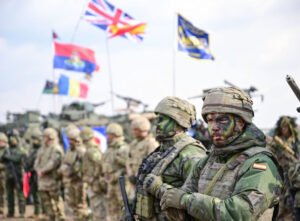At COP16, Biodiversity Credit Elevating Hopes and Protests — World Points


CALI, Columbia, Oct 26 (IPS) – On the finish of the primary week on the sixteenth Convention of Events on Biodiversity (COP16), finance emerges as the most important challenge but in addition shrouded in controversies.
On Saturday, because the COP moved nearer to its most vital part of negotiations, useful resource mobilization—listed beneath Goal 19 of the Kunming-Montreal World Biodiversity Framework (KMGBF)—took centerstage, with most events demanding quicker motion, higher transparency and the adoption of true options to halt biodiversity loss.
Biodiversity finance: Expectation vs Actuality
On Thursday, October 24, the federal government of China formally introduced that the Kunming Biodiversity Fund—first introduced by Chinese language president Xi Jinping in 2021—was now absolutely in operation. The fund guarantees to contribute USD 220 million over the subsequent 10 years, which might be spent particularly to assist creating international locations in implementation of the KMGBF and obtain its targets, stated Huang Runqiu, Minister of Setting and Ecology, China, at a press convention. It wasn’t clear, nevertheless, how a lot of the promised quantity had been deposited.
This has been the one information of useful resource mobilization for world biodiversity conservation acquired at COP16, as no different donors got here forth with any additional bulletins of recent monetary pledges or contributions to the World Biodiversity Framework Fund (GBFF), which was anticipated to obtain USD 400 billion in contribution by now however has solely acquired a paltry USD 250 million. As well as, there have been no bulletins of the international locations decreasing their present spending on dangerous subsidies that quantity to USD 500 billion and trigger biodiversity degradation and biodiversity loss.
In absence of recent contributions and lack of any concrete progress on discount of dangerous subsidies, the brand new mechanisms like biodiversity credit to mobilize assets for implementation of the World Biodiversity Fund is quick gaining traction.
From October 21–24, the COP16 witnessed a flurry of actions centered primarily round biodiversity credit and the constructing of recent pathways to mobilize finance by this implies. Consultants from each the UN and the personal sector have been heard at varied boards discussing the wants of creating instruments and methodologies that might assist mobilize new finance by biodiversity credit whereas additionally guaranteeing transparency.

Inclusiveness and the Questions
In line with a 2023 report by the World Financial Discussion board, the demand for biodiversity credit may rise to USD 180 billion yearly by 2050. The report stated that if main corporations stepped into the market, the annual demand for biodiversity credit may go to as excessive as USD 7 billion per yr by 2030.
Consultants from the UN and quite a lot of technical folks with varied backgrounds stated that since biodiversity credit are nonetheless of their infancy, there’ll undoubtedly be a whole lot of scrutiny and criticism. The Biodiversity Credit score Alliance is a gaggle that gives steering for the institution of a biodiversity credit score market. The pressing want, they stated, was to develop infrastructure and insurance policies that might assist reply these questions and sort out the scrutiny. The at the beginning of them was to assist construct digital instruments and infrastructure that could possibly be used to share and retailer biodiversity information in a reputable and clear method.
Nathalie Whitaker, co-founder of Toha Community in New Zealand, a gaggle of nature-based enterprise traders, stated that her group is constructing digital instruments, particularly for serving to native communities to take part in biodiversity credit score packages and entry the advantages.
“As soon as the communities have these instruments, they will immediately see what information is getting used to pay for the biodiversity credit and even resolve the worth of the pure sources of their territory. So, they will see what assets are being mentioned, what’s being valued, the way it’s being achieved and the way the entire dialogue is transferring ahead,” Whitaker stated.
Fabian Shimdt-Pramov, one other speaker on the occasion, stated that the standard of the instruments would resolve the course and outcomes of a biodiversity credit challenge.
Shimdt-Pramov, chief enterprise improvement officer at Biometric Earth, a German firm that makes use of synthetic intelligence to construct biodiversity analytics instruments from totally different sources reminiscent of distant sensing, wildlife cameras, acoustic monitoring, and many others.
“If methodology just isn’t right, if the info just isn’t right, the system does not work,” he stated, emphasizing on the requirement of high-level technological experience that’s wanted to get a biodiversity credit score challenge off the bottom.
Nevertheless, when questioned on the price of shopping for such high-end applied sciences and instruments, particularly by Indigenous communities dwelling in distant areas with none web connectivity, each audio system gave the impression to be puzzled.
“I’ve seen within the Amazon a group promoting 5 mahogany bushes on the web, so I’m guessing it is not a giant problem,” Shmidt-Pramov stated in a dismissive voice. Whitaker acknowledged that lack of entry to digital know-how in Indigenous Peoples communities was a difficulty however had no options to suggest.
Terence Hay-Edie of Nature ID, UNDP, nevertheless, harassed the necessity to empower the communities with the information and expertise that might assist them entry the instruments and be a part of a biodiversity credit score.
For instance, he cites restoration of river-based biodiversity as a biodiversity credit score challenge the place a river is taken into account to have the identical rights as a human being. In line with him, if values of credit are counted and traded for restoration of biodiversity round a river, it’ll require recognition of all these rights {that a} river has, which is just attainable when the group dwelling alongside the river has full information of what’s at stake, what’s restored, what worth of the restored biodiversity is to be decided and the way the pricing of that worth might be determined.
“A river is usually a authorized entity and have a authorized ID. Now, can we construct some instruments and put them within the arms of the group that’s doing the restoration to know the small print of it? That is what we’re taking a look at,” Hay-Edie stated.
A False Answer?
Nevertheless, Indigenous peoples organizations on the COP16 have been overwhelmingly opposing biodiversity credit, which they known as “commodifying nature.”
What are biodiversity credit? It is mainly regenerating biodiversity the place it’s destroyed and incomes cash from that. But it surely does not work that approach, in accordance with Souparna Lahiri, senior local weather change campaigner at World Forest Coalition.
“If we discuss of a forest, the ecosystem is not only about bushes however about each life that thrives in and round it—the rivers, the animals, vegetation, bees, bugs, flowers and all of the organisms. As soon as destroyed, it is misplaced without end. And while you regenerate it elsewhere, you possibly can by no means assure that it will likely be an actual reproduction of what has been misplaced. For this reason the very idea of biodiversity credit score is a damaging concept,” says Lahiri.
Valentina Figuera, additionally of the World Forest Coalition, stated that whereas buying and selling carbon credit may work as a instrument in carbon change mitigation, it will not be the identical in biodiversity.
“In local weather change, you possibly can measure the overall carbon generated by a forest, for instance. However in biodiversity, how do you measure it? What’s the mechanism? How do you even worth life that thrives there? So, this idea is a straight import from local weather change and forcefully imposed in biodiversity, which is nothing however a false resolution, so that companies that trigger biodiversity loss can conduct their enterprise as common.
The Dilemma of Participation
COP16, dubbed the “Folks’s Cop” by Colombia, the host nation, has drawn a number of hundred representatives of Indigenous Peoples and Native Communities (IPLC), particularly from throughout Latin America, together with Colombia, Brazil, Panama, Venezuela and Peru. Whereas the Latin American IPLC organizations appeared united of their opposition to biodiversity credit, African organizations gave the impression to be keen to contemplate it.
Mmboneni Esther Mathobo of the South African NGO Worldwide Institute of Setting stated that her group was in assist of biodiversity credit, which may, she stated, not solely assist the group earn cash but in addition inspire them additional to protect biodiversity.
“We’re influencing and ensuring that our rights are safeguarded and guarded on this newly rising market of bringing biodiversity credit,” stated Mathobo.
At the moment, Namibia is implementing its first biodiversity carbon credit challenge in partnership with the World Wildlife Fund (WWF). Generally known as the Wildlife Credit Scheme, the challenge is named a Cost for Ecosystem Companies (PES) that rewards communities for shielding wildlife and biodiversity. Mathobo stated that the challenge in Namibia made her understand that there was an ideal alternative for native communities to preserve and restore biodiversity and earn from it.
“We confronted many challenges to earn carbon credit as a result of that system was established and created behind our heads. And now we get up, however we discover ourselves sitting with a whole lot of issues in that market the place our communities aren’t even benefiting. However we consider that with the engagement of the biodiversity alliance, UNDP, we’re going to be those ensuring that no matter occurs within the biodiversity credit score market, it advantages all our areas and all our communities, in addition to safeguarding and defending our rights,” she stated.
“To every their very own, if Latin American indigenous communities really feel they do not need to commerce pure assets, that is their proper. However in Africa, we’ve the potential to earn biodiversity credit and we want the cash, so we’re supporting it,” Mahobo commented when reminded of the opposition of Latin American international locations to biodiversity credit.
Supply: World Financial Discussion board Report on Biodiversity Credit score
IPS UN Bureau Report
Comply with @IPSNewsUNBureau
Comply with IPS Information UN Bureau on Instagram
© Inter Press Service (2024) — All Rights ReservedAuthentic supply: Inter Press Service






